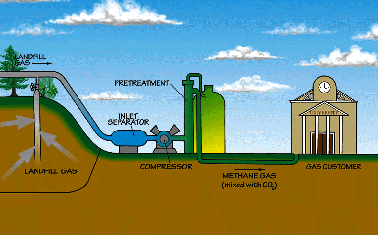landfill gas

Utilizing landfill gas.
All landfills generate a by-product known as landfill gas (LFG), a source of renewable energy that can be used either directly by industry or to generate electricity for public consumption.
Landfill gas contains approximately 50 percent methane, which makes it an excellent source of energy. On the down side, methane has a global warming potential of 21 relative to carbon dioxide. In other words, one tonne of methane produces the same greenhouse gas (GHG) effect as 21 tonnes of CO2. Capturing and converting LFG into energy prevents it from escaping into the atmosphere.
In addition to contributing to GHG emissions when released into the atmosphere, LFG has many other negative effects. These include disagreeable odors, health consequences from toxic and carcinogenic trace substances, and an increased risk of explosion from buildup at the landfill sites or in nearby buildings and other structures. The volatile organic compounds in LFG also contribute to smog and place stress on vegetation around the landfill. Fortunately, these effects can be prevented by capturing and using this valuable commodity.
There are two ways to manage LFG once it has been captured. It can be either flared (combusted under controlled conditions) or used as an energy source. When LFG is flared, the methane is converted into CO2. This reduces GHG emissions, eliminates odor problems and destroys contaminants. When LFG is used for energy, it conserves non-renewable sources of energy, such as fossil fuels. Either way, capturing and using LFG has a positive effect on climate change.
Two common uses for LFG are electricity generation – produced by running engines or steam turbines – and combustion as an alternative fuel. LFG can also be used directly by industry and to heat large buildings and greenhouses. Either method displaces the CO2 that would normally be released if fossil fuels had been burned.
See also rotary hammer drill.
